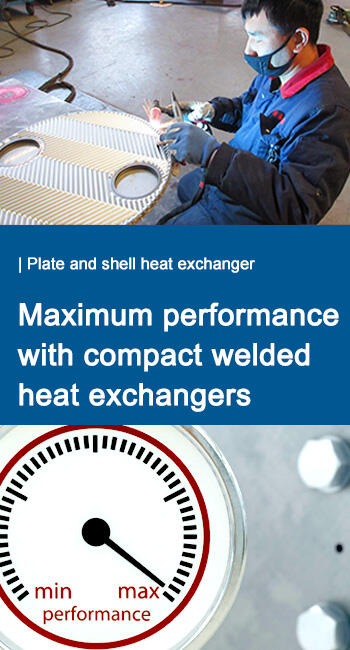Looking for a plate shell heat exchanger for the chemical industry? Then JINFAN is just right.
We are a first-class plate shell heat exchanger manufacturer & supplier. The advantages of shell and plate type heat exchanger include enhanced safety, high thermal efficiency, compact size, versatility, easy maintenance, and long service life. Welded plate construction be no longer used gaskets and seals, making it a reliable and efficient choice for a wide range of high-temperature industrial applications.
The plate shell heat exchanger combines the advantages of high heat transfer efficiency of plate heat exchangers and high pressure and temperature resistance of shell and tube heat exchangers. The core of plate shell exchanger structure replaces traditional tube bundles with fully welded corrugated plate bundles, resulting in a 30%+ increase in heat transfer efficiency. It is suitable for heat exchange conditions of various high-temperature, high-pressure, and highly corrosive media, and is widely used in chemical, power, pharmaceutical, metallurgical and other industries.
• Plate Pack (Core Unit)
Laser welding pairs of stainless steel plates form a flow channel unit. Multiple units are assembled into a cylindrical plate bundle, and the internal fluid flows in the plate channel.
• Shell Side Channel
The outer shell encloses the plate bundle, and the second fluid flows on the shell side to facilitate heat exchange with the fluid in the plates. The two media typically operate in countercurrent or cross-flow mode to achieve higher heat exchange efficiency.
• Fully Welded Structure
The plate bundle and the shell are fully welded and packaged, without gaskets, with good sealing and no leakage risks, especially suitable for high-risk or high-value fluids.
• Flexible Flow Channel Design
Single-pass, double-pass, and multi-pass structures can be set according to working conditions to meet the requirements of different flow rates, pressures, and heat transfer loads.

A plate shell heat exchanger consists of several corrugated metal plates stacked and welded together to form flow paths for two media. An outer shell surrounds the plate pack, creating a sealed chamber similar to a traditional shell-side heat exchanger. Heat is transferred between two fluids at different temperatures through conduction and convection across the metal plates.
The hot fluid enters the plate flow path or shell, while the cold fluid enters the other side. Due to the presence of the metal phe plates, the two fluids transfer heat without direct contact. Heat is transferred from the high-temperature fluid and carried away by the cold fluid, achieving efficient heat exchange. Finally, the two fluids, having completed the heat exchange, exit through their respective outlets. The unique corrugated design of the phe plate surface creates turbulent flow at relatively low flow rates, significantly improving the heat transfer coefficient. The welded and sealed plate flow paths provide a more stable structure and can withstand higher pressures and temperatures than traditional plate heat exchangers.

• High heat transfer efficiency
Strong turbulence is formed between the plates, and the heat transfer efficiency is much higher than that of traditional shell and tube heat exchangers (increased by about 3~5 times).
• Compact structure, Space-saving
Provides a larger heat transfer area per unit volume, the equipment is smaller and occupies less space.
• High pressure and high temperature resistance
Suitable for a maximum pressure of 6MPa and a high temperature of 400°C (customizable according to the material).
• Strong corrosion resistance
Stainless steel, titanium, Hastelloy, duplex steel and other materials can be selected, suitable for acid, alkali, high salt and special media.
• Maintenance-free, Long life
Gasket-free structure, reducing aging, replacement and maintenance costs, and supporting CIP online cleaning system.
| Category | Plate-and-Shell type | Shell-and-Tube type | Plate Heat Exchanger |
|---|---|---|---|
| Heat Transfer Efficiency | ★★★★☆ High | ★★☆☆☆ Medium | ★★★★★ Very High |
| Pressure Resistance | ★★★★☆ High | ★★★★★ Extremely High | ★★☆☆☆ Moderate |
| Disassemblability | Partially Disassemblable | Disassemblable | Disassemblable |
| Sealing Performance | Fully welded structure, no leakage | Flanged connections, prone to leakage | Gasket sealed, requires regular replacement |
| Footprint | Medium | Large | Small |
| Maintenance Frequency | Low | High | Medium |
💬 Let us help you find the best Plate Heat Exchanger model for you
"After switching to JINFAN shell & plate heat exchangers, our production line's heat exchange efficiency has significantly improved, energy consumption has been reduced by approximately 15%, and the equipment has taken up less space. The welded plate and shell structure allows the system to operate stably even in high-temperature and high-pressure environments."
"The traditional shell and tube heat exchangers we used previously were difficult to clean and maintain, often causing production downtime. Switching to JINFAN plate and shell exchangers has increased heat exchange efficiency by nearly 20%, extending production line uptime. The compact design also saves space."